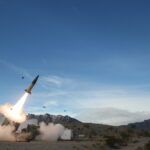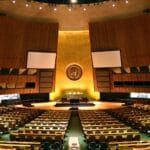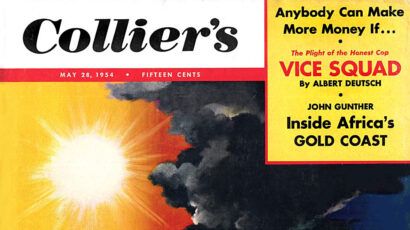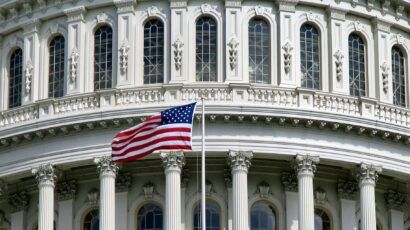Sidetrack or kickstart? How to respond to the US proposal on nuclear disarmament.
By Lyndon Burford, Oliver Meier, Nick Ritchie | April 19, 2019
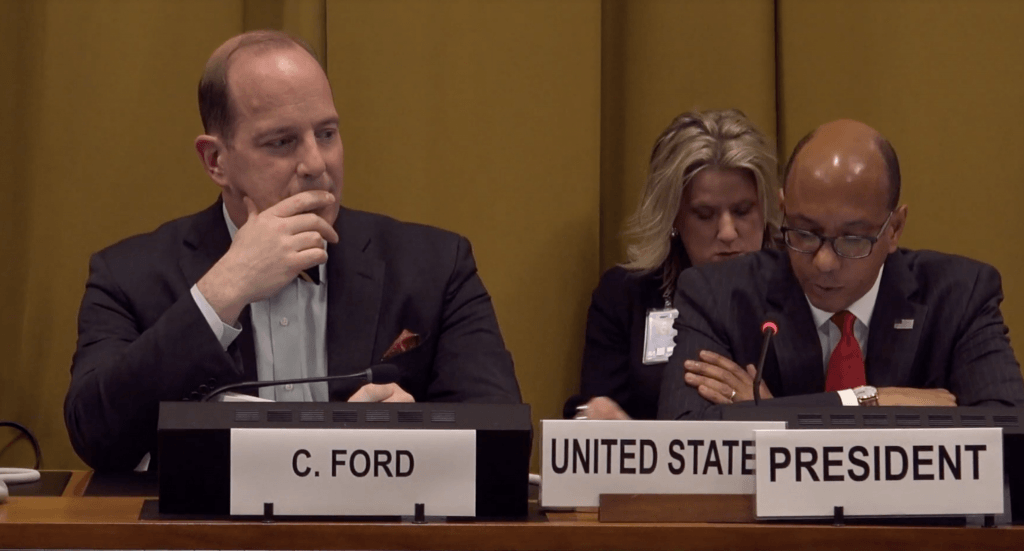 US Assistant Secretary of State for International Security and Non-proliferation Christopher A. Ford at the Conference on Disarmament.
US Assistant Secretary of State for International Security and Non-proliferation Christopher A. Ford at the Conference on Disarmament.
Speaking to the Geneva-based Conference on Disarmament on March 26, US Assistant Secretary of State Chris Ford presented the “Creating an Environment for Nuclear Disarmament” (CEND) initiative. According to Ford, the scheme “aims to help the international community find a path forward by setting in motion a ‘Creating an Environment Working Group’ process.” He described CEND as a “pathbreaking new initiative” to bring countries together in a constructive dialogue to explore how “it might be possible to ameliorate conditions in the global security environment so as to make that environment more conducive to further progress toward—and indeed, ultimately to achieve—nuclear disarmament.”
Ford’s Geneva speech was a continuation of US outreach stretching back more than a year. The relative novelty of Ford’s presentation in front of the Conference on Disarmament was the new name for the initiative, changed from “Creating the Conditions” to “Creating the Environment” for nuclear disarmament. US Undersecretary of State Andrea Thompson had noted this development in remarks to the Carnegie International Nuclear Policy Conference on March 11, where she acknowledged that Washington had encountered “a bit of a rub” with the conditions-based narrative in initial consultations with allies and permanent members of the UN Security Council, or P5. The renaming from “conditions” to “environment” appears to take this criticism into account. The name change is important because it points to the initiative’s key problem: the risk that the United States and other nuclear weapon states will use the process of Creating an Environment for Nuclear Disarmament to deflect pressures to take concrete action on disarmament.
Nevertheless, the US initiative is to be applauded. Obviously, there are many obstacles to nuclear disarmament, not least political will. Identifying, understanding, and overcoming these hurdles is an urgent task, in which the United States has a major part to play. Other interested states, and particularly US allies, should therefore engage with the initiative, but with the following caveats: First, the process should be inclusive and the states involved should have equal ownership. Second, the agenda and terms of reference for the initiative, or its working group, must address the responsibility of nuclear weapon states for the lack of progress on nuclear disarmament. Third, the United States must be willing to listen and to “seriously address what others think are meaningful and realistic dangers posed by nuclear weapons,” as George Perkovich put it. A process in which Washington enjoys undue control over both the proceedings and the working group is unlikely to achieve the outcomes desired.
What’s in a name? Shifting from conditions to progress. While the shift from “creating the conditions” to “creating the environment” suggests a willingness to listen (at least, to allies and P5 states), a closer comparison between Ford’s Geneva remarks and his earlier statements on the subject leads one to be sceptical. The Geneva speech does not substantively move beyond the conditions narrative. Ford consistently and repeatedly argues that disarmament can only move forward when and if the prevailing security conditions are improving. This focus is problematic for a number of reasons.
First, it is conservative and unimaginative; it highlights the barriers to disarmament, rather than exploring ways to make progress. It therefore serves primarily the interests of the nuclear weapon countries, which are reluctant to give up their nuclear weapons. France, Russia and the United States, among others, argue that competition among great powers has to be overcome before meaningful steps towards a world free of nuclear weapons can be seriously considered. But making such a revolutionary transformation of international politics a precondition for nuclear disarmament limits the possibilities for progress from the outset.
Second, the conditions framework ignores that nuclear disarmament is not only dependent on the general state of world affairs but, due to the increased transparency, verification, and technical and political cooperation that would necessarily be involved in any serious disarmament progress, disarmament would itself make a major contribution to the lessening of risks and international enmity. The conditions paradigm does not adequately capture this interrelationship between security and disarmament. For example, “creating the conditions” for nuclear disarmament might not be possible as long as the world’s major powers remain committed to a system of security based on nuclear deterrence. Moving away from nuclear deterrence might therefore itself be an essential cause of improved security relationships that would enable nuclear disarmament, rather than just being a symptom of insecurity. Any working group established in the name of advancing nuclear disarmament must be empowered to consider such possibilities alongside the assumptions that drive more traditional approaches.
Third, nuclear weapon states often highlight the “conditions” for nuclear disarmament, mainly to argue that others are responsible for the fact that these conditions are “not ripe” yet. Speaking at Wilton Park, Ford pointed the finger at “revisionist” nuclear powers and in Geneva, he continued to lament a global strategic environment that is less conducive to further disarmament progress than it has been in decades. He does not reflect, however, on how actions such as US abrogation of its commitments under the Joint Comprehensive Plan of Action or its 2002 withdrawal from the Anti-Ballistic Missile Treaty have contributed to that environment.
Since the main arms races currently taking place are between the nuclear weapon states themselves, proliferation risks must not be misused as an excuse for increasing reliance on nuclear weapons. To avoid the proposed working group degenerating into a short-lived blame game, the United States would need to demonstrate “security dilemma sensibility”—that is, to recognize that other countries may feel threatened by US actions or weapons procurements, even if Washington sees them as purely defensive. For all nuclear-armed states, acknowledging the legitimacy of other states’ security concerns will be important to move the dialogue towards actionable steps.
Fourth, the “conditions” narrative is perceived by many as a stepping away from Nuclear Non-Proliferation Treaty (NPT) disarmament commitments, including specifically the disarmament Action Plan agreed by NPT states parties at the 2010 Review Conference. The United States and other nuclear weapon states have been trying to diminish the importance of such commitments by arguing that they were concluded under different, arguably “better” circumstances. Speaking in the UK House of Lords on December 12, Ford challenged the idea that disarmament is one of the three pillars of the NPT, calling that idea an “artefact” of procedural choices made in the 1980s and describing it as a turn of phrase adopted subsequently by NPT states parties “for reasons merely of convenience.” He vehemently denied that disarmament is a co-equal element of the NPT, alongside non-proliferation. This position is at odds with positions shared by the vast majority of parties to the treaty and goes against agreements contained in multiple NPT consensus documents.
It remains to be seen whether the relabelling of the CCND to the CEND indicates a readiness to assess the role of all nuclear weapons countries in generating a strategic environment that they judge is not conducive for significant steps towards nuclear disarmament. Meanwhile, other participants should pursue a forward-looking approach that fully takes into account the interdependencies between nuclear disarmament, reduced tensions and collective security.
Run with it! But faster, together, and in many directions. As Ambassador Guilherme de Aguiar Patriota of Brazil noted in the discussion of the CEND initiative in the Conference on Disarmament in March, a framework for the dialogue on a way forward would require careful negotiations on venue, content, approaches, roles, and participation. A first consideration in these regards is that creating collective ownership of the CEND initiative is important. Group members should aim for an inclusive discussion, addressing a range of views about the dangers posed by nuclear weapons, immediate steps, and longer-term, broader, underlying changes in political, economic and military relations. If they cannot have equal standing within the working group, and thus, the ability to insist that these type of issues are discussed, other states should stay away from the Creating the Environment Working Group process and think about alternative pathways for taking nuclear disarmament forward.
Relationship with the NPT. The results of the CEND working group (and its subgroups), including specific commitments on nuclear disarmament, could help countries agree on meaningful steps to take the NPT forward, particularly with regard to implementing disarmament obligations under Article VI of the Treaty. The working group could and should therefore be aimed at creating “deliverables” for meetings of NPT states parties. The working group members could present an outline of the group’s work program and promise to deliver policy recommendations on selected issues for the 2020 Review Conference. Ideally, the working group’s results could provide ideas for further developing the 2010 Action Plan by identifying concrete steps the nuclear weapons states will take to improve the environment for nuclear disarmament.
But the working group should not be limited to producing input for NPT meetings. Nuclear disarmament is an important topic in and of itself. Participants should avoid establishing direct linkages of the working group to NPT membership, agendas, or schedules. The deliberations and outcomes of the working group will undoubtedly find political traction in a range of diplomatic forums. The group should feed into the NPT review cycle but not be bound by it, because the overarching security-political problems that prevent disarmament are not structured solely by the NPT’s review cycles, nor limited to its membership or thematic remit. In this sense, a failure of the 2020 NPT review conference to agree on a final document should not reduce the importance of conclusions reached by the working group members.
A meaningful agenda. The working group’s agenda is the key factor affecting its legitimacy, effectiveness, and sustainability. In Geneva, Ford did not specify criteria for issues to be included in the work plan. In his Wilton Park speech in December, he simply stated that the group should consider issues that “if addressed effectively, could improve prospects for progress on nuclear disarmament.” He referred to the US Working Paper to the 2018 NPT Preparatory Committee, in which the United States lists some 15 conditions that would have to be met for disarmament to be taken forward.
Harvard researcher Rebecca Gibbons has somewhat diplomatically observed that this is a list of US aims that “may not be inclusive of what other countries would prioritize.” Those interested in joining the working groups could use this list as a starting point but insist that all relevant issues are included, including those that nuclear weapon states are reluctant to discuss. Much ink has already been spilled on next steps on nuclear disarmament, including the Canberra Commission on the Elimination of Nuclear Weapons, the Weapons of Mass Destruction Commission, and the International Commission on Nuclear Non-Proliferation and Disarmament. The core challenge remains mobilizing the collective political will to take practical steps forward and working out effective measures that could precipitate a deeper transformation of global nuclear politics. In this regard, the issue of how the CEND working group relates to the Treaty on the Prohibition of Nuclear Weapons (often called the ban treaty) will be important.
The United States and other nuclear-armed states have not engaged with the ban treaty. Ford has dismissed it as “magical thinking” and even counterproductive because it alienates the nuclear weapon countries. While he is of course entitled to his view, the CEND working group will itself lack legitimacy if it sets itself up in opposition to the ban treaty. First, the group of ban treaty supporters is now so large that its voice will have to be heard in the CEND process. Second, this group makes a strong case that delegitimizing nuclear weapons is part and parcel of a process of creating the environment for nuclear disarmament. The working group needs to acknowledge and address this argument. The alternative approach of sidelining and deriding ban treaty supporters and their perspective is certain to put the CEND process on a track where its agenda will be seen as selective and reflecting only one specific view of the global nuclear disarmament discourse.
A comprehensive, balanced CEND working group program could then include the following topics:
- The disarmament-deterrence conundrum: Nuclear weapon states maintain that nuclear weapons can have a positive influence on the maintenance of peace. This is a contested proposition. Others argue that deterrence relationships reduce security, see nuclear deterrence as an impediment to disarmament, and challenge the efficacy of nuclear deterrence as a war prevention strategy.
- Upholding existing treaty architecture/compliance: One obstacle to disarmament progress is the lack of commitment to existing obligations. This concerns commitments made in the NPT but also compliance with and commitments to the Intermediate-range Nuclear Forces Treaty (INF), New START, and the Iran nuclear deal, among others. Working group members could discuss how to increase commitments to existing political and legal obligations and how to deal with steps away from such agreements. They could also explore how the global nuclear governance architecture might evolve if formal arms reduction treaties prove difficult to negotiate.
- Regional tensions: Clearly, regional tensions and the prospects for nuclear disarmament are interconnected. But the role of nuclear weapon states in increasing regional tensions also needs to be addressed. For example, US abrogation of its commitment to the Iran nuclear deal makes the environment for nuclear disarmament worse. The working group could aim to discuss how nuclear weapon states can help to reduce regional tensions, including by bolstering agreements that aim to limit the role of nuclear deterrence in such circumstances.
- Secrecy/verification: The lack of transparency by nuclear weapon states and nuclear alliances needs to be addressed. Nuclear weapon states are privileged vis-à-vis non-nuclear weapon states because they are not obligated to put civil nuclear activities under safeguards. They have also been reluctant to accept additional reporting requirements on nuclear policies and nuclear weapon postures. Reducing this transparency gap among NPT members would be an important measure towards better accountability by the nuclear weapon states and provide a better factual basis for discussions on arms control and disarmament measures.
Inclusiveness. Ford’s Geneva-speech is entitled “Our Vision for a Constructive, Collaborative Disarmament Discourse.” He argued that “there is likely to be no path forward that does not involve sincere and constructive engagement by a broad range of parties” and suggested that “perhaps” there is “something we can learn” from the International Partnership for Nuclear Disarmament Verification (IPNDV). Washington established the IPNDV in December 2014 with State Department funding, and in recent years, China and Russia have ceased participation with the group, factors that have contributed to a perception that Washington dominates the group and its work.
Ford proposed that CEND participants would come together “in an initial plenary in order to develop a constructive agenda, and then meeting in a range of working groups to try to address the challenges thus identified.”
To take advantage of such an approach, each of the nuclear weapon states could be invited to co-chair a subgroup to the CEND working group alongside a non-nuclear weapon state. These co-chairs should represent a variety of views and come from different backgrounds, including from the global North and South, ban treaty supporters and sceptics. The selection of chairs should be a democratic and bottom-up process, in which nuclear weapon states are not privileged. Anything less would damage the credibility of the exercise.
Realistically, the working group will also need to adopt creative funding mechanisms that allow for meaningful participation by experts from the Global South. Likewise, the executive secretariat should not be solely US-funded and “staffed by the United States,” as suggested by Ford in Wilton Park. Maintaining a sense among participants that they have collective ownership of the practical, day-to-day operations of the working groups will be vital to ensuring the overall group’s independence. Similarly, participants would need to discuss whether it makes sense to outsource organizational matters to a US non-governmental organization or whether there are other institutions better suited.
Working group membership. Speaking at Wilton Park, Ford suggested that 25 to 30 states will be selected to participate in the working group. In Geneva, he said that the United States “would be delighted to see participants from across all the world’s relevant political divisions: weapons states, non-weapons states, developed countries, less-developed countries, alliance states, G-77 states, NPT States Party, NPT non-parties, and so forth.” Yet, he left open the question who would select participants and on what basis. Participants should take Washington at its word and make sure that both supporters of the nuclear weapons ban treaty and supporters of nuclear deterrence participate.
The appropriate size of the group is a more difficult issue to decide. To be sure, if the group is to provide a framework for meaningful discussion, it should not be too large. One way to start the process may be for nuclear-armed, Non-Proliferation and Disarmament Initiative, and New Agenda Coalition participants (which span a range of positions on nuclear disarmament) to jointly decide on the group’s initial composition and basis for admitting further states to the working group. All states could then apply for membership and decisions would be taken on the basis of an open, transparent process.
The reaction of Conference on Disarmament members to the approach laid out in Ford’s March speech was cautiously positive. In a brief exchange, all P5 states spoke, with Russia praising the initiative as a “signal of hope,” although it also stated that the Conference on Disarmament “remained the optimum and perhaps the only platform to address the lack of nuclear disarmament” and that it was therefore “not necessary to reinvent the wheel.” China stated that it would regard CEND as the US “contribution to the implementation of” NPT Article VI. Notably, ban treaty supporters were the only group of Conference on Disarmament members not ready to engage with the US initiative.
So for the time being, the Creating the Environment for Nuclear Disarmament working group is only an idea, but it could offer a new opportunity for states to engage on progress towards nuclear disarmament. It could be a serious, honest, and open forum to discuss the responsibilities of all states, including the nuclear weapon states, in helping create the conditions for nuclear disarmament and taking specific steps in that direction. For that to happen, however, participating states must have shared ownership, including financial buy-in as appropriate, to make sure that they have an equal say in the make-up and functioning of the group and the conclusions it reaches over time.
Together, we make the world safer.
The Bulletin elevates expert voices above the noise. But as an independent nonprofit organization, our operations depend on the support of readers like you. Help us continue to deliver quality journalism that holds leaders accountable. Your support of our work at any level is important. In return, we promise our coverage will be understandable, influential, vigilant, solution-oriented, and fair-minded. Together we can make a difference.
Keywords: Conference on Disarmament
Topics: Analysis, Nuclear Weapons




